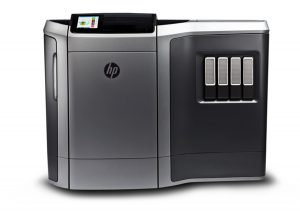 Hewlett-Packard (NYSE:HPE) is ready to release its first 3D printer, the HP Jet Fusion 3D Printing Solution. Originally unveiled in October 2014, the new HP Jet Fusion printer is the world’s first production-ready commercial 3D printing system. HP has been allowing nearly a dozen companies, including Nike, BMW, Johnson & Johnson, and Siemens, to test the Jet Fusion printing technology in its labs. The new models were unveiled to the public today at RAPID 2016 and the company has begun taking orders for the devices.
Hewlett-Packard (NYSE:HPE) is ready to release its first 3D printer, the HP Jet Fusion 3D Printing Solution. Originally unveiled in October 2014, the new HP Jet Fusion printer is the world’s first production-ready commercial 3D printing system. HP has been allowing nearly a dozen companies, including Nike, BMW, Johnson & Johnson, and Siemens, to test the Jet Fusion printing technology in its labs. The new models were unveiled to the public today at RAPID 2016 and the company has begun taking orders for the devices.
HP says that the printer will enable the mass production of parts through additive manufacturing. The company claims that the new printers will be up to 10 times faster than existing machines and operate at half the cost of similar 3D printing methods. The new Jet Fusion printers have a print area or a print bin of 16-in. x 12-in. x 16-in and are about the size of two washing machines. The printers also come with a set of tools that includes software, processing stations and cooling systems.
HP is releasing two models of the new machines. The 3200 series is the lower cost model and is designed for prototyping. The 3200 series will be available for purchase in mid-2017 and will have a starting price of about $130,000. The more sophisticated 4200 series is 25 percent faster than the 3200 series and is designed for short-run manufacturing. The 4200 series will begin shipping to manufacturers in October of this year and will have a starting price in low $200,000 range.
.
The HP Jet Fusion system also comes with a separate post-processing station, which removes excess powder and allows users to prepare printed parts for use. Printed parts must be allowed to cool and then be pulled from a bin of powder and cleaned before use. The post-processing stations are sold separately from the printers for about $25,000. HP has not released pricing for the materials to be used with the new printers.
The 3D printers can be used to produce items that cannot be made with injection molding, CNC machines or other traditional manufacturing techniques. It can use any combination of colors to create an object. They will also be able to print electronics in the parts they created using conductive materials printed at the voxel level. HP aims to add security, such as invisible codes in 3D printed parts, for supply chain tracking.
